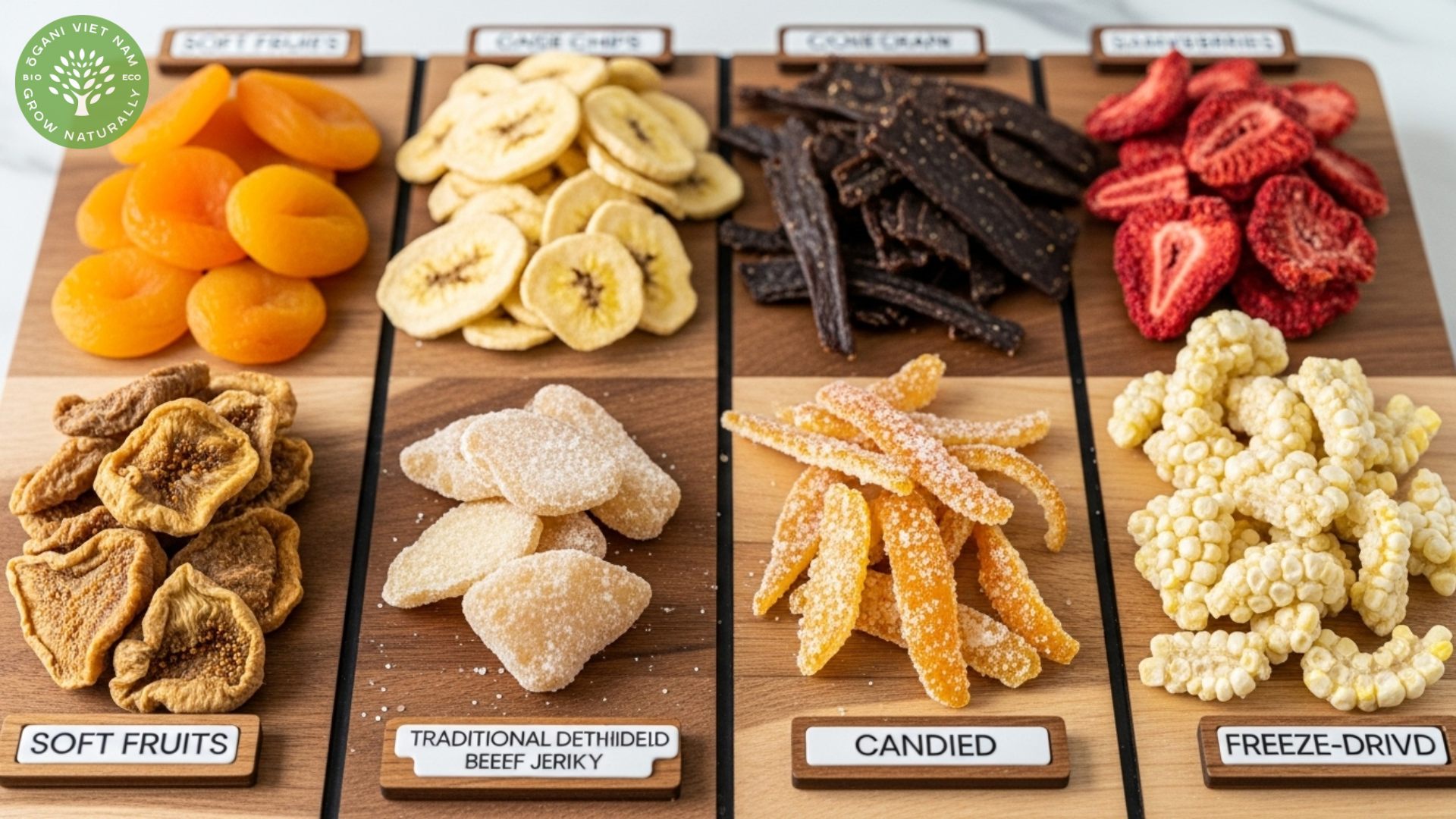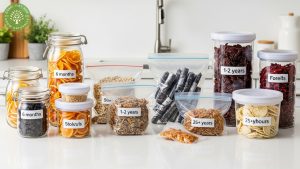
When it comes to keeping food fresh for longer, the method you choose makes all the difference. Whether it’s soft-dried, regular-dried, candied, or freeze-dried, each way brings its own feel — a change in taste, texture, and even how the food makes you remember its original form.
At Ogani VN, we’ve taken the time to understand each process, not to rush it, but to keep the best part of nature in every piece we make.
Drying isn’t just about removing water — it’s about keeping the story inside the fruit alive, so you can still taste a bit of sunshine in every bite.
Soft dried vs regular vs candied vs freeze dried: Understanding the differences
There’s more than one way to dry food, and each way tells its own story.
Over the years, people have found different ways to keep fruit and other ingredients fresh — from simple air drying to the modern magic of freeze-drying.
Soft-dried, regular-dried, candied, or freeze-dried — every method changes how much water stays inside and how the flavor develops. Some keep the chew, some keep the crunch, some keep the sweetness.
When you know the difference, you start to see how each belongs in your kitchen — not just for storage, but for the joy of tasting something truly cared for.
Regular drying: The traditional approach
Regular drying is the old, simple way — just warm air and time. The heat slowly pulls the water out until most of it’s gone, maybe eighty or ninety percent.
It takes anywhere from six hours to a full day, depending on what you’re drying and how thick it is.
Fruits turn darker, taste sweeter, and get that chewy, leathery feel that makes them easy to snack on.
Vegetables dry out harder, sometimes even brittle. Most of them need soaking again before cooking, but they keep their flavor — honest and strong.
Soft drying: Gentle preservation technique
Soft drying is the slower, kinder way to dry food. You don’t take out all the water — just enough so it keeps a bit longer. The fruit stays soft, bends a little when you press it, still feels alive somehow.
It loses maybe sixty to eighty percent of its moisture, but it keeps its taste, its color, and most of its goodness.
It doesn’t last as long as the fully dried kind, that’s true. But what you get is food that feels closer to how it was picked — gentle, not tired.
Candied preservation: Sweet transformation
Candying is different. You don’t dry the fruit — you trade its water for sugar. Bit by bit, the sweetness seeps in while the juice fades out.
It takes time. The fruit sits in hot syrup until it turns glossy, heavy, almost see-through.
When it’s done, it’s no longer just fruit. It’s soft, chewy, a little sticky on your fingers. Sweet in a way that makes you stop for a second before the next bite.
If you keep it dry and sealed, it stays good for months. Old hands in the kitchen say sugar keeps memories as well as it keeps fruit.
Texture comparison: Soft dried vs regular vs candied vs freeze dried methods
The real difference between these methods shows up the moment you take a bite. Each one changes the texture in its own way — chewy, crisp, or tender — giving every food a different feel and a different kind of pleasure.
Freeze-dried: Light and crunchy transformation

Freeze-dried foods are made through a simple bit of science: frozen water inside the food turns straight into vapor, skipping the melting stage. Almost all moisture — about 99% — disappears, yet the shape and color stay the same.
What’s left is something impossibly light and crisp, a bite that almost disappears on your tongue. Of all drying methods, freeze-drying changes texture the most — turning chewy into airy, dense into delicate.
Even candies like Skittles puff up in the process, going from sticky to shatter-crisp — a small, sweet miracle that’s easy on the teeth and fun to bite into.
Regular dried: Dense and chewy consistency
As regular dried foods lose moisture, they grow dense and chewy. The structure tightens with time, giving each bite a firm, satisfying pull.
That chew is part of their charm — steady, filling, and perfect for long walks or trail mixes where you want something that lasts, both in texture and taste.
Textural advantages of different methods
| Method | Texture | Moisture Content | Eating Experience |
|---|---|---|---|
| Soft Dried | Pliable, tender | 20-40% remaining | Easy chewing, moist |
| Regular Dried | Dense, chewy | 10-20% remaining | Requires significant chewing |
| Candied | Sweet, crystalline | 15-25% remaining | Intense sweetness, varied texture |
| Freeze Dried | Light, crunchy | 1-2% remaining | Dissolves quickly, intense flavor |
Nutritional benefits: Soft dried vs regular vs candied vs freeze dried comparison
Each drying method changes how much goodness a food keeps — its nutrients, its freshness, even its spirit. Knowing these differences helps you choose the way that fits your health, your taste, and the way you like to store food.
Nutrient retention: Soft dried vs regular vs candied vs freeze dried analysis
Freeze-drying keeps most of what’s in the food. Low heat means fragile vitamins survive, and the fruit or veggie stays almost as alive as when it was picked.
Regular drying works, but the heat takes a toll. Vitamin C and other delicate nutrients fade away the longer it’s cooked and dried.
Soft drying sits in the middle. Gentler heat, shorter time — it keeps more of the food’s original life while still letting it last long enough to enjoy later.
Storage duration capabilities
Soft dried, regular, candied, and freeze-dried foods all live on very different timelines. Freeze-dried foods can last 25–30 years if sealed tight, ready for emergencies.
Regular dried fruits usually hold up for 1–2 years. Soft dried fruits, softer and more tender, stay fresh for 6–12 months. Candied fruits sit somewhere in between, keeping their sweetness for about 12–18 months when stored well.
Cost comparison: Soft dried vs regular vs candied vs freeze dried options
Budget and what’s on hand often guide the choices we make with food. Some methods need fancy machines and patience, others just a pot and a little time. How much you can give — in money, in effort — shapes not just what you preserve, but how it feels to do it.
Equipment and processing costs

Freeze-drying takes the biggest upfront investment — home machines can cost $2,000 to $5,000. For those who love preserving food and want it to last, the long shelf life and nutrients make it worth it.
Regular dehydrators are far cheaper, $50 to $300, and easy for most households to use. That’s why regular drying is the go-to for home kitchens.
Soft drying often uses the same machines as regular drying, just gentler and shorter. Candying is simple too — a pot, some sugar, and patience, though sugar costs add up over time.
Commercial availability and pricing
Commercial freeze-dried foods cost more because the process is tricky and uses lots of energy. Still, with their long shelf life, they can be worth it over time.
Soft dried, regular, candied, and freeze-dried foods show clear price differences. Regular dried fruits are the cheapest, while specialty freeze-dried items can run three to five times higher per serving.
Best applications: Soft dried vs regular vs candied vs freeze dried uses

Picking the right drying method isn’t just about technique — it’s about how you want to enjoy the food, how long you need it to last, and what textures make you happiest. Each method has its own magic, shining brightest when it meets the right food and the right purpose.
Optimal uses for freeze-dried foods
Freeze-dried foods shine when you need something light, full of nutrients, and made to last. Backpackers and those preparing for emergencies love them — they carry so much without weighing you down.
The airy, crisp texture of freeze-dried candies has opened up a whole new world of snacking — familiar flavors in a playful, surprising form. At Ogani VN, we’ve watched health-conscious customers reach for these again and again, drawn by both taste and the joy of something different.
Traditional applications for other methods
Regular dried foods are the classics — perfect for baking, trail mixes, or any time you want a chewy bite that feels satisfying. Their flavors are concentrated and full, especially when rehydrated in a recipe, bringing the food back to life.
Candied foods shine in their own way, with intense sweetness and playful textures that make desserts or decorations feel special and joyful.
Soft dried fruits are best when you want to enjoy them soon or keep them for a short time, holding just enough of their original texture to feel alive in every bite.
Storage and handling requirements
How you store dried foods makes a big difference in how long they last and how good they stay. Each method has its own little rules to keep the flavors, textures, and freshness at their best.
Environmental control needs

All dried foods do best in a cool, dry spot, but each method has its own needs. Freeze-dried items are the most delicate — even a tiny bit of moisture can spoil them, so they need extra care.
Soft dried, regular, candied, and freeze-dried products all need protection from humidity, but for freeze-dried foods, using oxygen absorbers and moisture-proof containers is essential to keep them at their best for the long term.
Packaging needs: Soft dried vs regular vs candied vs freeze dried storage
Airtight containers are a must for all dried foods, but the way you store them can make a big difference. Freeze-dried items shine when tucked into mylar bags with oxygen absorbers inside sturdy containers.
Regular and soft dried foods are happy in standard airtight jars, while candied products sometimes need a bit more care to keep them from sticking or forming crystals — small steps that make every bite feel just right.
Frequently Asked Questions
Which drying method preserves the most nutrients? Freeze-drying keeps 85–95% of the food’s original nutrients, making it the best for holding onto vitamins. The gentle, low-heat process protects delicate nutrients that other methods might destroy.
How long does each type of dried food last? Freeze-dried foods can last 25–30 years if stored well. Regular dried foods usually last 1–2 years, soft dried fruits about 6–12 months, and candied foods around 12–18 months.
What’s the most cost-effective drying method for home use? Regular drying offers the best mix of affordability and ease. The equipment is inexpensive, and the process is straightforward, even for beginners.
Can you make freeze-dried foods at home? Yes, but it’s a big commitment — home freeze-dryers cost $2,000–$5,000. Most people start with regular dehydration before moving on to freeze-drying.
Which method works best for emergency food storage? Freeze-dried foods are perfect for emergencies, thanks to their 25–30 year shelf life and strong nutrient retention. Regular dried foods are a more budget-friendly option, lasting 1–2 years while still keeping you fed.
Making the right choice: Soft dried vs regular vs candied vs freeze dried
Understanding soft dried, regular, candied, and freeze-dried methods helps you choose the right way to preserve food for your life — what you need, what you can afford, and how you like to store it. Each method has its own little magic, bringing out different flavors, textures, and joys in your kitchen.
At Ogani VN, we usually suggest starting with regular drying for home use, then exploring other methods as you get more comfortable. The right tools aren’t just about equipment — they help you waste less food, keep more nutrients, and feel prepared for whatever comes next.
Ready to start your food preservation journey? Check out our selection of drying equipment and preserved foods, and talk with our experts for advice that fits your home, your taste, and your budget.
Read more:
- Red Dragon Fruit Powder (Pink Pitaya): Benefits, Uses & Buying Tips
- Pitaya Powder: Complete Guide to Benefits & Uses
- What Is Soft Dried Fruit? Process, Moisture Level & Why It’s Different
- Organic Dried Mango Wholesale: Premium Quality from Ogani VN
- Unsweetened Vs No Sugar Added Vs Low Sugar Dried Mango: What’s The Difference?

